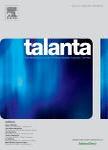版权所有:内蒙古大学图书馆 技术提供:维普资讯• 智图
内蒙古自治区呼和浩特市赛罕区大学西街235号 邮编: 010021

作者机构:Shahrekord Univ Dept Agr Machinery Engn Fac Agr Shahrekord Iran Univ Valladolid ETS Ingenieros Ind Dept Inorgan Chem Valladolid Spain Univ Tehran Fac Agr Engn & Technol Agr Machinery Engn Dept Karaj Iran Univ Fed Paraiba CCEN Dept Quim BR-58051970 Joao Pessoa Paraiba Brazil Inst Tecnol Aeronaut Div Engn Eletron BR-12228900 Sao Jose Dos Campos SP Brazil
出 版 物:《TALANTA》 (Talanta)
年 卷 期:2012年第89卷
页 面:286-291页
核心收录:
学科分类:081704[工学-应用化学] 07[理学] 08[工学] 0817[工学-化学工程与技术] 070302[理学-分析化学] 0703[理学-化学]
基 金:Iran National Science Foundation (INSF) Spanish Ministry of Science [AGL2009-12660/ALI] CNPq CAPES
主 题:Beer Ageing Near infrared spectroscopy Wavelength selection Classification Successive Projections Algorithm Linear Discriminant Analysis
摘 要:This work proposes a method for monitoring the ageing of beer using near-infrared (NIR) spectroscopy and chemometrics classification tools. For this purpose, the Successive Projections Algorithm (SPA) is used to select spectral variables for construction of Linear Discriminant Analysis (LDA) classification models. A total of 83 alcoholic and non-alcoholic beer samples packaged in bottles and cans were examined. To simulate a long storage period, some of the samples were stored in an oven at 40 degrees C, in the dark, during intervals of 10 and 20 days. The NIR spectrum of these samples in the range 12,500-5405 cm(-1) was then compared against those of the fresh samples. The results of a Principal Component Analysis (PCA) indicated that the alcoholic beer samples could be clearly discriminated with respect to ageing stage (fresh, 10-day or 20-day forced ageing). However, such discrimination was not apparent for the nonalcoholic samples. These findings were corroborated by a classification study using Soft Independent Modelling of Class Analogy (SIMCA). In contrast, the use of SPA-LDA provided good results for both types of beer (only one misclassified sample) by using a single wavenumber in each case, namely 5550 cm(-1) for non-alcoholic samples and 7228 cm(-1) for alcoholic samples. (C) 2011 Elsevier B.V. All rights reserved.